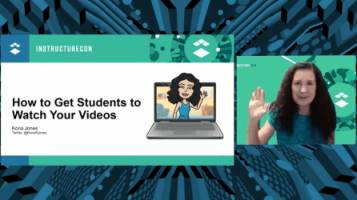At InstructureCon 2021 , I attended Kona Jones’s session, How to Get Students to Watch Your Videos. I’m a big fan of Kona’s. She is Director of the Teaching & Learning Center at Richland Community College in Decatur, IL, adjunct professor of Statistics and formerly of Developmental Psychology, and a Canvas Community Coach. I’ve attended her sessions at past conferences: InstructureCon and Online Teaching Conference, and I’ve always learned super helpful and practical tips. Her session at this year’s InstructureCon was no exception. She presented on her top five tips for getting students to watch instructional videos based on student feedback. Here’s a summary of what her students said:
Tip #1: Keep it short and chunk the content.
Six is the magic number. Kona’s students were most likely to watch her videos if they were up to approximately six minutes in duration. You’ve probably heard the recommendation to keep instructional videos short, but this recommendation gives you a specific, concrete amount of time to aim for. In order to keep videos short, it is critical to break your content into small chunks, ideally 6-ish minute chunks. Of course, shorter videos are fine, but the longer beyond six minutes your video is, the more likely it is that students will lose interest and stop paying attention or stop watching your video.
Tip #2: Students want to see and hear you.
Students want to watch videos made by you and starring YOU. Since you are the expert teaching the course, students prefer hearing from you instead of watching say a TEDtalk video. Plus when students see and hear you, it helps to humanize your course and in turn increase engagement and reduce equity gaps. So don’t be shy! Record yourself lecturing on a topic, explaining an assignment, or providing feedback.
Tip #3: Focus on what’s MOST important.
It’s all important. That’s why you’re teaching it, right? But it’s not practical or effective to make videos of everything that you teach in a course. Instead focus on clarifying the muddiest points that students struggle with or that are not explained well in the textbook. Include stories, examples, or analogies to help students understand those topics.
Tip #4: Emphasize the learning value of the video.
Students are more likely to watch videos with a clear connection to the assignments and exams. Often, students don’t read between the lines; the connection must be made explicit for them to understand the purpose and importance of watching the video. Kona says her students love it when she makes videos explaining an assignment itself just like she would in a face-to-face course. In making these videos, she ends up adding bits of information that she hadn’t included in the written instructions which students find extra helpful.
Tip #5: Keep it engaging and have fun!
It’s ok if your video isn’t perfect. That actually keeps the video more engaging for students. So if your kids or pets interrupt your video or you make a mistake, leave it in. Don’t edit it out, or put it at the end of the video as an outtake. You might even add in Easter eggs to your videos to make them extra fun and perhaps offer extra credit if they spot them.
Want More?
Watch Kona’s full session, How to Get Students to Watch Your Videos, for additional tips in each of these five categories.
What’s your favorite tip? How do you get your students to watch your videos? Tell us in the comments below!

